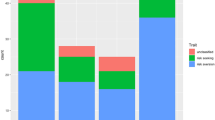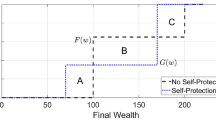Abstract
From the perspective of parents, redistributive taxation can be seen as social insurance for their children, for which no private alternative exists. Because private insurance comes too late during a person's life, it cannot cover the same risks as social insurance. Empirically, 85% of social insurance covers risks for which no private insurance would have been available. Redistributive taxation can be efficiency enhancing, because it creates safety and because it stimulates income generating risk taking. However, it also brings about detrimental moral hazard effects. Both the enhancement of risk taking and the moral hazard effects tend to increase the inequality in the economy, and, under constant returns to risk taking, this increase is likely to be strong enough even to make the net-of-tax income distribution more unequal. Optimal redistributive taxation will either imply that the pie becomes bigger when there is less inquality in pre-tax incomes or that more redistribution creates more post-tax inequality.
Similar content being viewed by others
References
AhsanS.M. (1974). “Progression and Risk-Taking,” Oxford Economic Papers 26, 318–328.
AhsanS.M. (1976). “Taxation in a Two-Period Temporal Model of Consumption and Portfolio Allocation,” Journal of Public Economics 5, 337–352.
AlesinaA., and D.Rodrik (1994). “Distributive Politics and Economic Growth,” Quarterly Journal of Economics 109, 465–490.
AllinghamM.G. (1972). “Risk Taking and Taxation,” Zeitschrift für Nationalökonomie 32, 203–224.
AtkinsonA.B. (1970). “On the Measurement of Inequality,” Journal of Economic Theory 2, 244–263.
AtkinsonA.B. (1991). “Social Insurance,” The Fifteenth Annual Lecture of the Geneva Association, Geneva Papers on Risk and Insurance Theory 16, 113–131.
Atkinson, A.B. (1995). The economic Consequences of Rolling Back the Welfare State, Munich Lectures in Economics, forthcoming with MIT-Press: Cambridge, Mass.
AtkinsonA.B., and J.Stiglitz (1980). Lectures on Public Economics, McGraw-Hill Book Company: New York.
BambergG., and W.F.Richter (1984). “The Effects of Progressive Taxation on Risk-Taking,” Zeitschrift für Nationalökonomie 44, 93–102.
BarrN. (1992). “Economic Theory and the Welfare State: A Survey and Interpretation,” Journal of Economic Literature 30, 741–803.
BoadwayR.W., and D.Wildasin (1990). “Optimal Tax-subsidy Policies for Industrial Adjustment to Uncertain Shocks,” Oxford Economic Papers 42, pp. 105–134.
Böhm-BawerkE.von (1889). Kapital und Kapitalzins, Zweite Abteilung: Positive Theorie des Kapitals, Verlag der Wagner'schen Universitäts-Buchhandlung: Innsbruck.
BuchananJ.M., and G.Tullock (1962). The Calculus of consent, University of Michigan Press: Ann Arbor.
Bucholz, W. (1987). Risikoeffekte der Besteue rung, University of Tübingen, unpublished habilitation thesis.
BulowJ.I., and L.H.Summers (1984). “The Taxation of Risky Assets,” Journal of Political Economy 92, 20–39.
Christiansen, V. (1990). “Subsidization of Risky Investment under Income Taxation and Moral hazard,” Warwick Economic Research Paper No. 357, Dpt. of Economics, University of Warwick.
CrucigerG. (1921). Transportversicherung, Steinebach: München.
DiamondP.H., L.J.Helms, and J.A.Mirrlees (1980). “Optimal Taxation in a Stochastic Economy,” Journal of Public Economics 14, 1–29.
DomarE., and R.A.Musgrave (1944). “Proportional Income Taxation and Risk-Taking,” Quarterly Journal of Economics 58, 388–422.
EatonJ., and H.S.Rosen (1980). “Taxation, Human Capital, and Uncertainty,” American Economic Review 70, 705–715.
EhrlichI., and G.S.Becker (1972). “Market Insurance, Self-Insurance, and Self-Protection,” Journal of Political Economy 80, 623–648.
FeldsteinM. (1969). “The Effects of Taxation on Risk Taking,” Journal of Political Economy 77, 755–764.
FisherI. (1907). The Rate of Interest, Macmillan: New York.
FriedmanM. (1953). “Choice, Chance, and the Personal Distribution of Income,” Journal of Political Economy 61, 277–290.
GordonR.H. (1985). “Taxation of Corporate Capital Income: Tax Revenues versus Tax Distortions,” Quarterly Journal of Economics 100, 1–27.
HarsanyiJ.C. (1953). “Cardinal Utility in Welfare Economics and the Theory of Risk-Taking,” Journal of Political Economy 61, 434–435.
HarsanyiJ.C. (1955). “Cardinal Welfare, Individualistic Ethics and Interpersonal Comparisons of Utility,” Journal of Political Economy 63, 309–321.
KanburR. (1979). “Of Risk Taking and the Personal Distribution of Income,” Journal of Political Economy 87, 769–97.
Kant, I. (1785). Grundlegung zur Metaphysik der Sitten, Riga.
Kaplow, L. (1991). “A Note on Taxation as Social Insurance for Uncertain Labor Income,” NBER Working Paper No. 3708.
KaplowL. (1992). “Income Tax Deductions for Losses as Insurance,” American Economic Review 82, 1013–1017.
KonradK. (1991). “Risk Taking and Taxation in Complete Capital Markets,” The Geneva Papers on Risk and Insurance Theory 16, 167–177.
KonradK. (1992). Risikoproduktivität, Springer-Verlag: Berlin, Heidelberg and New York.
MeyerS. (1987). “Two-Moment Decision Models and Expected Utility Maximization,” American Economic Review 77, 421–430.
MirrleesJ.A. (1995). “Private Risk and Public Action: The Economics of the Welfare State,” European Economic Review 39, 383–397.
Perotti, R. (1992). “Income Distribution, Politics, and Growth,” American Economic Review 82, Papers & Proceedings, 311–316.
PerssonT., and G.Tabellini (1994). “Is Inequality Harmful for Growth?,” American Economic Review 84, 600–620.
PigouA.C. (1932). The Economics of Welfare, McMillan: London.
RawlsJ.A. (1971). A Theory of Justice, Harvard University Press: Cambridge, Mass.
RochetJ.Ch. (1991). “Incentives, Redistribution and Social Insurance,” Geneva Papers on Risk and Insurance Theory 16, 143–165.
SandmoA. (1977). “Portfolio Choice, Asset Demand and Taxation,” Review of Economic Studies 44, 369–379.
SandmoA. (1991). “Economists and the Welfare State,” European Economic Review 35, 213–239.
ShavellS. (1979). “On Moral Hazard and Insurance,” Quarterly Journal of Economics 93, 541–562.
SinnH.-W. (1978). “The Efficiency of Insurance Markets,” European Economic Review 11, 321–341.
SinnH.-W. (1981). “Die Grenzen des Versicherungsstaates. Theoretische Bemerkungen zum Thema Einkommensumverteilung, Versicherung und Wohlfahrt,” in: H.Göppl and R.Henn, eds., Geld, Banken und Versicherungen, Athenäum: Königstein, pp. 907–928. Reprinted in: G.Rolf, P.B.Spahn and G.Wagner, eds., Sozialvertrag und Sicherung-zur ökonomischen Theorie: staatlicher Versicherungs-und Umverteilungssysteme, Campus: Frankfurt and New York 1988, pp. 65–84.
SinnH.-W. (1983). Economic Decisions under Uncertainty, North Holland: Amsterdam, New York and Oxford (Second edition: Physica: Heidelberg 1989).
SinnH.-W. (1986). “Risiko als Produktionsfaktor,” Jahrbücher für Nationalökonomie und Statistik 201, 557–571.
SinnH.-W. (1988). “Gedanken zur volkswirtschaftlichen Bedeutung des Versicherungswesens,” Zeitschrift für die gesamte Versicherungswissenschaft 77, 1–27.
SinnH.-W. (1990). “Expected Utility, μ-σ Preferences, and Linear Distribution Classes: A Further Result,” Journal of Risk and Uncertainty 3, 277–281.
SinnH.-W. (1995). “A Theory of the Welfare State,” Scandinavian Journal of Economics 97, pp. 495–526.
StiglitzJ.E. (1969). “The Effects of Income, Wealth, and Capital Gains Taxation on Risk Taking,” Quarterly Journal of Economics 83, 263–283.
TimmH. (1961). “Das Gesetz der wachsenden Staatsausgaben,” Finanzarchiv 21, 201–247.
VarianH. R. (1980). “Redistributive Taxation as Social Insurance,” Journal of Public Economics 14, 49–68.
WagnerA. (1876). Allgemine oder theoretische Volkswirtschaftslehre: Erster Theil, Grundlegung, Winter'sche Verlagshandlung: Leipzig und Heidelberg.
Author information
Authors and Affiliations
Additional information
The author gratefully acknowledges reserach assistance by Claudio Thum and useful comments by two anonymous referees. The paper is a broadened and non-technical discussion that draws on previous writings by the author on the subject. See in particular Sinn (1995).
Rights and permissions
About this article
Cite this article
Sinn, HW. Social insurance, incentives and risk taking. Int Tax Public Finan 3, 259–280 (1996). https://doi.org/10.1007/BF00418944
Issue Date:
DOI: https://doi.org/10.1007/BF00418944




